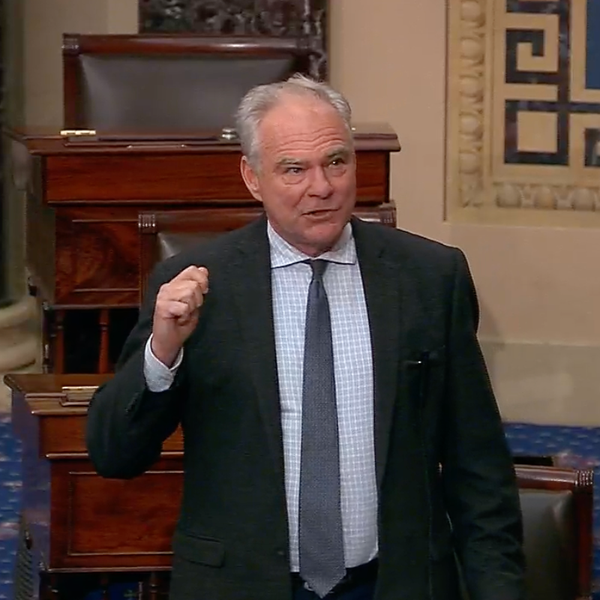Rep. Anthony Brown, D-Md., a member of the Armed Services Committee currently serving his third term in the U.S. House, recently published an op-ed in Defense News that argues “we should not irresponsibly cut defense spending as a way to offset the costs” of President Biden’s American Jobs Plan and American Families Plan.
"We cannot 'rob Peter to pay Paul,'" he adds.
Unfortunately, Rep. Brown paints with far too broad a brush in appearing to claim that no part of the defense budget should be scrutinized or reduced by Congress.
Rep. Brown points to global threats as a reason for a growing defense budget. However, the United States spends more on defense than the next ten nations combined — $732 billion vs. $726 billion in 2019, according to the Stockholm International Peace Research Institute. That includes “great power” adversaries Rep. Brown mentions like China and Russia that, despite ranking second and fourth on this list of high defense-spending countries, do not even come close to approaching the U.S. government’s annual commitments to defense.
Rep. Brown argues we need a large defense budget to care for “two million service members and civilians” who “devote their lives to our defense.” He’s absolutely correct that the U.S. government must do well by the people who admirably and courageously serve our country in the military. However, spending on personnel is only part of the defense budget picture: $154.7 billion of $712.6 billion in fiscal year 2020 Department of Defense funding, or 22 percent. Surely Rep. Brown doesn’t mean to suggest that there’s not a dollar of waste or inefficiency in the remaining 78 percent of the annual budget?
And Rep. Brown proudly notes that the Defense Advanced Research Projects Agency made an investment in Moderna in 2013 that helped the company ultimately develop and bring to market one of several safe, effective COVID-19 vaccines. While Americans can and should be proud that public-private partnerships put three American vaccines in world citizens’ arms in record time, the 2013 DARPA investment amounted to $25 million, or about four one-thousandths (0.004) of a percent of the FY 2014 DoD budget.
The Congressman is correct that the U.S. military does many important things. But it is bad faith to argue that modest cuts to the defense budget would result in a U.S. loss to China or Russia in “great power” competition, or cuts to the pay and benefits of U.S. troops, or even a lack of future medical innovations that combat deadly diseases.
President Biden has proposed a FY 2022 DoD discretionary budget of $715 billion. The final “defense budget” number, when accounting for mandatory spending and Department of Energy spending that’s classified as national defense programming, will be higher than that $715 billion figure. Defense hawks have pointed out that, in real terms, that’s a slight cut from the FY 2021 DoD discretionary budget of $705 billion (or $723 billion in October 2020 dollars).
Consider this, though: the FY 2022 Biden DoD budget proposal — widely regarded as a compromise between hawks that want to increase the budget three to five percent and progressive lawmakers who want to cut the budget — is 11 percent higher in real terms than the FY 2003 DoD budget, spent as Washington was starting the Iraq War and a year-plus into the nation’s War on Terror. The Biden budget proposal is 11 percent higher now even as the President prepares for a full military withdrawal from Afghanistan by September 11, 2021, which may save taxpayers up to $50 billion per year.
The FY 2022 Biden DoD budget proposal is functionally flat from the budgets of the past few years even as the Biden administration previously pledged to review the $1.7-trillion F-35 program, a boondoggle for taxpayers that lawmakers insist on continuing to fund (and purchase more of) even as the aircraft fails on multiple readiness and safety metrics.
The FY 2022 Biden DoD budget proposal is flat even as national security and budget experts from across the ideological spectrum propose a number of ‘low hanging fruit’ cuts for the upcoming year that would harm neither U.S. personnel nor research initiatives that come out of DARPA.
As for China and Russia, the U.S. can and should compete with these nations in the realms Rep. Brown mentions — security, diplomacy, trade, and more — but there are lower-cost interventions than a multi trillion-dollar failing aircraft or an ever-growing Naval fleet.
The U.S. can combat China with a robust defense of U.S. intellectual property protections and by engaging in free trade agreements with China’s regional sphere of influence. It can combat Russian interference in U.S. democratic institutions by investing in enhanced public- and private-sector cybersecurity efforts. These are but small pieces of a much larger puzzle, but they are all less costly interventions than failing or bloated legacy programs — and, indeed, are less costly in lives and treasure than two-decade foreign engagements in nations like Afghanistan.
The pandemic has also demonstrated an evolving definition of what it means to be safe and secure in America. At one point during this deadly and tragic pandemic, we were losing more Americans per day than we lost on September 11. The point here is not to compare devastating tragedies, but to demonstrate that all the planes, ships, bullets, and weapons in the world could not keep us safe from COVID-19 — but just a few billion dollars in preparedness efforts now could help prevent the next pandemic.
Ultimately, many of the things Rep. Brown speaks of should be widely agreeable to most Americans — an America that is safe and secure from foreign adversaries, U.S. military personnel that are well compensated for their sacrifices, and breakthrough medical innovations and cures that save lives today and tomorrow. We just don’t need a higher DoD topline to accomplish all of these things. Reducing waste and inefficiency in the DoD budget could fund some of the investments mentioned above and, more importantly, reduce the record-level debt and deficits that military leaders admit are a threat to national security.















